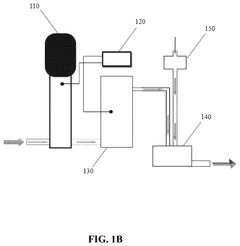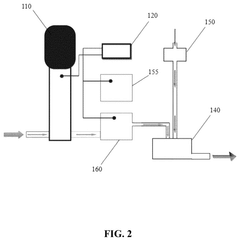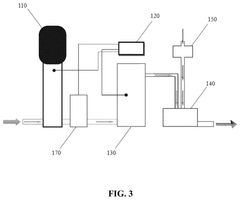Studying Plasmoid Effects on Planetary Radiation Belts
Plasmoid-Radiation Belt Interaction Background
The study of plasmoid effects on planetary radiation belts represents a critical area of space physics research, bridging the gap between solar-terrestrial interactions and planetary magnetospheric dynamics. Plasmoids, which are coherent structures of plasma and magnetic fields, play a significant role in the transport of energy and particles within planetary magnetospheres.
Planetary radiation belts, discovered by James Van Allen in the 1950s, are regions of high-energy charged particles trapped by a planet's magnetic field. These belts, primarily composed of electrons and protons, are found in the inner magnetospheres of planets with strong magnetic fields, such as Earth, Jupiter, and Saturn.
The interaction between plasmoids and radiation belts is a complex phenomenon that has garnered increasing attention in recent years. Plasmoids, often generated during magnetic reconnection events in the magnetotail, can inject substantial amounts of plasma and energy into the inner magnetosphere, significantly altering the dynamics of radiation belts.
Historical observations have shown that the Earth's radiation belts can undergo dramatic changes during geomagnetic storms, which are often associated with the arrival of solar wind-driven plasmoids. These events can lead to the acceleration of particles to relativistic energies, causing the expansion or contraction of the belts, and potentially posing risks to satellite operations and space-based technologies.
The study of plasmoid-radiation belt interactions has evolved significantly since the early space age. Initial observations were limited to in-situ measurements from a small number of satellites. However, with the advent of multi-spacecraft missions and advanced remote sensing techniques, researchers have gained a more comprehensive understanding of these complex interactions.
Recent technological advancements, such as the Van Allen Probes mission, have provided unprecedented insights into the microphysics of radiation belt dynamics. These observations have revealed the importance of wave-particle interactions, magnetosphere-ionosphere coupling, and the role of plasmoids in driving these processes.
Understanding the effects of plasmoids on planetary radiation belts is crucial for several reasons. Firstly, it contributes to our fundamental knowledge of space plasma physics and magnetospheric dynamics. Secondly, it has practical implications for space weather forecasting and the protection of space-based assets. Lastly, comparative studies of different planetary magnetospheres can provide valuable insights into the universal processes governing plasma behavior in diverse astrophysical environments.
As we continue to explore our solar system and beyond, the study of plasmoid-radiation belt interactions remains a vibrant and evolving field. Future research directions include the development of more sophisticated numerical models, the deployment of advanced space-based observatories, and the exploration of radiation belts around other planets and moons in our solar system.
Space Weather Forecasting Demand
Space weather forecasting has become increasingly critical in our technologically dependent society. The demand for accurate predictions of space weather events, particularly those affecting planetary radiation belts, has grown significantly across various sectors. Satellite operators, telecommunications companies, power grid managers, and aviation industries all rely heavily on space weather forecasts to protect their assets and ensure uninterrupted services.
The global space weather forecasting market is experiencing rapid growth, driven by the expanding satellite industry and increasing awareness of space weather impacts. As more countries and private companies launch satellites for communication, navigation, and Earth observation, the need for reliable space weather information has intensified. This demand extends beyond traditional users to include emerging sectors such as space tourism and commercial spaceflight operations.
Government agencies, particularly those involved in national security and defense, are major stakeholders in space weather forecasting. Military operations, GPS-guided systems, and radar communications are all susceptible to space weather disturbances. Consequently, there is a strong push for advanced forecasting capabilities to safeguard critical infrastructure and maintain operational readiness.
The scientific community has also expressed a growing interest in improved space weather forecasting. Researchers studying climate change, atmospheric dynamics, and solar-terrestrial interactions require accurate space weather data to enhance their models and understanding of complex Earth systems. This scientific demand drives innovation in forecasting techniques and technologies.
In the private sector, insurance companies are increasingly factoring space weather risks into their policies for satellite operators and other space-dependent industries. This has created a new market segment for specialized space weather forecasting services tailored to risk assessment and mitigation strategies.
The rise of artificial intelligence and machine learning has opened new avenues for space weather forecasting. There is a strong demand for AI-driven predictive models that can process vast amounts of solar and magnetospheric data to provide more accurate and timely forecasts. This technological shift is reshaping the landscape of space weather services and creating opportunities for innovative startups and established tech companies alike.
As our understanding of plasmoid effects on planetary radiation belts advances, there is a corresponding increase in demand for more sophisticated forecasting tools. Stakeholders are seeking not only predictions of space weather events but also detailed analyses of their potential impacts on specific systems and regions. This evolving demand is driving research into new observation techniques, data integration methods, and predictive algorithms focused on plasmoid dynamics and their interactions with radiation belts.
Current Challenges in Plasmoid-Belt Studies
The study of plasmoid effects on planetary radiation belts presents several significant challenges that researchers are currently grappling with. One of the primary difficulties lies in the complex and dynamic nature of the interactions between plasmoids and radiation belts. These interactions involve multiple physical processes occurring simultaneously, making it challenging to isolate and quantify individual effects.
A major hurdle is the limited observational data available for studying plasmoid-belt interactions in situ. While spacecraft missions have provided valuable insights, the vast spatial and temporal scales involved in these phenomena make comprehensive coverage difficult. This lack of continuous, high-resolution data hampers our ability to fully understand the dynamics of plasmoid injections and their subsequent impact on radiation belt particles.
Another challenge is the development of accurate and computationally efficient models that can simulate plasmoid-belt interactions across multiple scales. Current models often struggle to capture the full range of physical processes involved, from the microscale plasma dynamics to the global magnetospheric response. Bridging this gap requires innovative approaches in multi-scale modeling and advanced computational techniques.
The variability of plasmoid characteristics and their effects on different planetary magnetospheres poses an additional challenge. Each planet's magnetic field configuration and plasma environment are unique, necessitating tailored approaches for studying plasmoid-belt interactions in different planetary systems. This diversity complicates efforts to develop unified theories or models applicable across various planetary contexts.
Furthermore, the transient nature of plasmoid events makes their detection and characterization difficult. Plasmoids can form and dissipate rapidly, and their effects on radiation belts may evolve over varying timescales. Developing robust methods for identifying and tracking plasmoid signatures in observational data remains an ongoing challenge.
The interdisciplinary nature of plasmoid-belt studies also presents obstacles in integrating knowledge from different fields. Researchers must combine expertise from plasma physics, magnetospheric physics, and planetary science to fully understand these complex phenomena. Fostering collaboration and knowledge exchange across these disciplines is crucial for advancing our understanding of plasmoid effects on radiation belts.
Lastly, the challenge of distinguishing plasmoid-induced changes in radiation belts from other magnetospheric processes adds another layer of complexity. Radiation belt dynamics are influenced by various factors, including solar wind conditions and internal magnetospheric processes. Isolating the specific contributions of plasmoids requires sophisticated data analysis techniques and careful interpretation of observational and modeling results.
Plasmoid Detection Methods
01 Plasmoid generation and confinement
This category focuses on methods and devices for generating and confining plasmoids, which are self-contained plasma structures. These techniques are crucial for studying radiation belts and plasma physics in controlled environments. The approaches may include magnetic confinement, electrostatic fields, or other advanced methods to create and maintain stable plasmoid configurations.- Plasmoid generation and confinement: This category focuses on methods and devices for generating and confining plasmoids, which are self-contained plasma structures. These techniques are crucial for studying radiation belts and plasma physics in controlled environments. The approaches may include magnetic confinement, electrostatic fields, or specialized chamber designs to create and maintain stable plasmoids.
- Radiation belt monitoring and measurement: This area involves technologies for monitoring and measuring radiation belts, including Earth's Van Allen belts. It encompasses satellite-based instruments, ground-based detectors, and data analysis techniques to study the composition, intensity, and dynamics of radiation belts. These measurements are essential for understanding space weather and its effects on satellite operations and space exploration.
- Plasma-based propulsion systems: This category covers propulsion systems that utilize plasmoids or plasma for spacecraft propulsion. These technologies aim to provide efficient and high-speed propulsion methods for space exploration and satellite maneuvering. The systems may involve pulsed plasma thrusters, magnetoplasmadynamic thrusters, or other plasma-based propulsion concepts.
- Radiation shielding for spacecraft: This area focuses on developing advanced radiation shielding techniques for spacecraft and astronauts operating in radiation belt environments. It includes materials science approaches, active shielding methods using electromagnetic fields, and innovative spacecraft designs to mitigate the harmful effects of high-energy particles in radiation belts.
- Plasmoid-based fusion research: This category encompasses research into fusion energy generation using plasmoid concepts. It includes experimental devices, theoretical models, and diagnostic tools for studying plasmoid behavior in fusion-relevant conditions. The goal is to explore the potential of plasmoid-based approaches for achieving controlled nuclear fusion and understanding plasma dynamics in extreme environments similar to those found in radiation belts.
02 Radiation belt monitoring and measurement
This area involves technologies for monitoring and measuring radiation belts, including Earth's Van Allen belts. It encompasses various sensors, detectors, and instruments designed to analyze the composition, intensity, and dynamics of charged particles trapped in planetary magnetic fields. These tools are essential for understanding space weather and its effects on satellite operations and space exploration.Expand Specific Solutions03 Plasma-based propulsion systems
This category covers innovative propulsion systems that utilize plasmoids or plasma technology for spacecraft propulsion. These systems aim to provide efficient and high-speed propulsion methods for space exploration and satellite maneuvering. The technology may involve pulsed plasma thrusters, magnetoplasmadynamic thrusters, or other plasma-based propulsion concepts.Expand Specific Solutions04 Radiation shielding and protection
This point focuses on developing advanced materials and techniques for shielding against radiation in space environments, particularly within radiation belts. It includes innovative designs for spacecraft shielding, personal protective equipment for astronauts, and methods to mitigate the effects of high-energy particles on electronic components and biological systems during space missions.Expand Specific Solutions05 Artificial radiation belt creation and manipulation
This category explores methods for creating artificial radiation belts or manipulating existing ones. It includes techniques for injecting charged particles into the magnetosphere, altering the Earth's magnetic field, or creating localized plasma regions for scientific study or potential applications in space weather control and communication enhancement.Expand Specific Solutions
Key Space Agencies and Research Institutions
The study of plasmoid effects on planetary radiation belts is in an early developmental stage, with a growing market as space exploration and satellite technology advance. The field's technical maturity is still evolving, with key players like Harbin Institute of Technology, University of Maryland Baltimore County, and National University of Defense Technology leading research efforts. These institutions are focusing on understanding the complex interactions between plasmoids and radiation belts, which is crucial for improving space weather predictions and satellite operations. The market size is expanding as more countries and private companies invest in space-related technologies, driving demand for advanced knowledge in this area. As the field progresses, collaboration between academic institutions and space agencies is likely to accelerate technological advancements and practical applications.
Beijing Institute of Satellite Environmental Engineering
Harbin Institute of Technology
Breakthrough Plasmoid-Belt Interaction Models
- A system that generates nanoplasmoids in a fluid using a modular shearing section and electrolytic cell, with a source of energy such as microwave or ultrasound, to produce plasmoids with diameters less than 1 μm, incorporating a vortex mixing plate and shear mixing segments to create a stable suspension.
- A controller system that adjusts the inductance-to-resistance (L/R) time constant and provides additional axial current pulses based on real-time measurements from probes, maintaining the toroidal to poloidal magnetic field ratio within optimal thresholds to stabilize the plasma.
International Space Collaboration Frameworks
International space collaboration frameworks play a crucial role in advancing the study of plasmoid effects on planetary radiation belts. These frameworks facilitate the sharing of resources, expertise, and data among nations, enabling more comprehensive and efficient research efforts. The International Space Station (ISS) serves as a prime example of successful multinational cooperation, providing a unique platform for conducting experiments and observations related to space plasma physics.
Collaborative initiatives such as the International Living With a Star (ILWS) program, coordinated by NASA and involving multiple space agencies, focus on understanding the effects of space weather on Earth and other planets. This program encompasses research on plasmoids and their interactions with planetary magnetospheres, fostering a global approach to studying radiation belt dynamics.
The Committee on Space Research (COSPAR) provides another essential framework for international cooperation in space science. COSPAR organizes scientific assemblies and symposia, bringing together researchers from various countries to exchange knowledge and coordinate efforts in studying plasmoid-radiation belt interactions. These events serve as catalysts for forming international research teams and initiating joint projects.
Bilateral and multilateral agreements between space agencies also contribute significantly to the study of plasmoid effects. For instance, collaborations between NASA and ESA, or JAXA and Roscosmos, have led to joint missions and data-sharing initiatives that enhance our understanding of planetary radiation belts. These partnerships often involve the development and deployment of specialized instruments and spacecraft designed to measure plasmoid properties and their impact on radiation belt dynamics.
International data-sharing platforms and repositories, such as the International Space Science Institute (ISSI) and the World Data System (WDS), play a vital role in disseminating research findings and raw data. These resources enable scientists worldwide to access and analyze information on plasmoid-radiation belt interactions, fostering a collaborative approach to scientific discovery.
The United Nations Office for Outer Space Affairs (UNOOSA) provides a global forum for discussing and coordinating international space activities, including those related to space weather and its effects on planetary environments. Through its various committees and working groups, UNOOSA helps to establish guidelines and best practices for space research, ensuring that studies on plasmoid effects adhere to international standards and protocols.
As the complexity of space missions increases, international collaboration becomes increasingly essential. Future frameworks may involve more integrated global efforts, such as a coordinated network of satellites and ground-based observatories dedicated to studying plasmoid-radiation belt interactions across multiple planets in our solar system. These collaborative endeavors will be crucial in advancing our understanding of space plasma physics and its implications for planetary environments.
Environmental Impact of Space Weather
Space weather, primarily driven by solar activity, has significant environmental impacts on Earth and other planets in our solar system. The study of plasmoid effects on planetary radiation belts is crucial for understanding these impacts. Radiation belts, also known as Van Allen belts, are regions of charged particles trapped by a planet's magnetic field. These belts are particularly sensitive to space weather events, which can cause dramatic changes in their structure and intensity.
Solar storms, such as coronal mass ejections (CMEs) and solar flares, release large amounts of energy and particles into space. When these events interact with Earth's magnetosphere, they can cause geomagnetic storms. These storms can lead to the injection of energetic particles into the radiation belts, significantly altering their composition and dynamics. The enhanced particle populations in the belts can pose risks to satellites, astronauts, and even ground-based technologies.
The environmental impact of space weather extends beyond the immediate effects on radiation belts. Geomagnetic storms can induce currents in power grids, potentially causing widespread blackouts. They can also interfere with radio communications and GPS signals, disrupting various sectors including aviation, maritime operations, and emergency services. In extreme cases, these storms may even impact pipelines and railway systems by inducing currents in long metal structures.
Furthermore, space weather events can have atmospheric effects. The interaction between solar particles and the upper atmosphere can lead to beautiful auroral displays but can also cause changes in atmospheric chemistry. This can result in increased ozone depletion in polar regions and affect the overall energy balance of the atmosphere, potentially influencing long-term climate patterns.
The study of plasmoid effects on planetary radiation belts is not limited to Earth. Other planets with magnetic fields, such as Jupiter and Saturn, also have radiation belts that are affected by space weather. Understanding these effects across different planetary environments provides valuable insights into the broader implications of space weather on planetary systems.
As our reliance on space-based technologies grows, so does our vulnerability to space weather events. This underscores the importance of continued research into plasmoid effects on radiation belts and their environmental impacts. Improved understanding in this area will enable better prediction and mitigation strategies, helping to safeguard our technological infrastructure and potentially inform future space exploration efforts.







